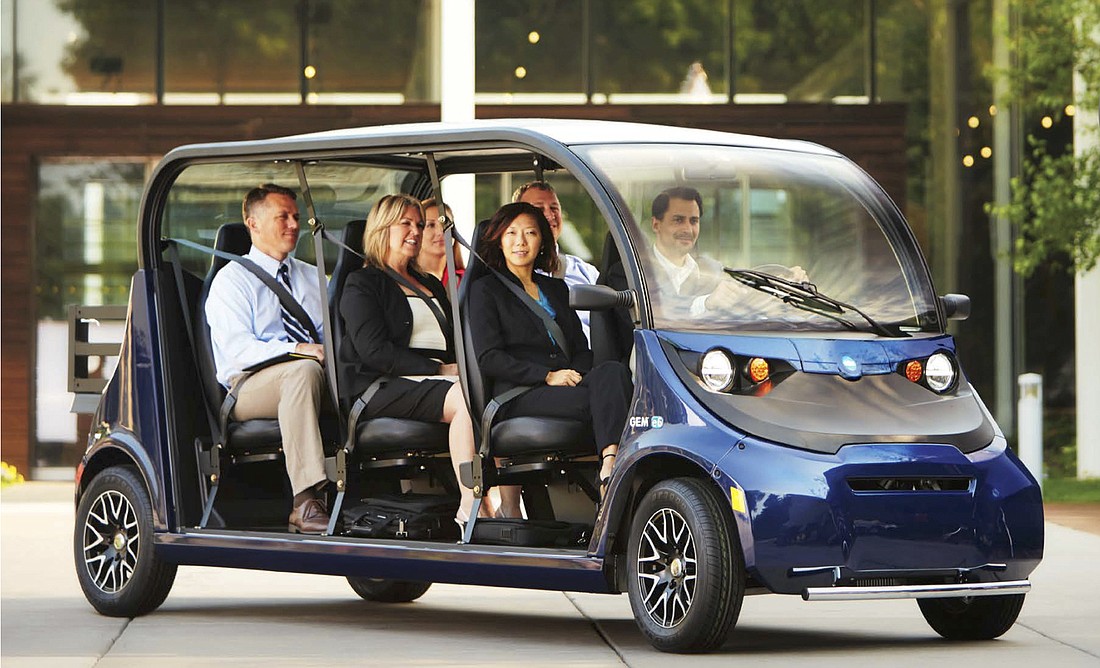- April 17, 2024
-
-
Loading

Loading

John Moran has spent five years examining a series of peculiar-looking vehicles. Now, he thinks he’s finally found the one.
It’s a six-seat electric car, similar in style to a golf cart, although an enclosed configuration is also offered. It tops out at 25 mph, but it’s still street legal (as long as it doesn’t travel on roads with a speed limit over 35 mph). Most importantly, it’s equipped with a lithium ion battery that lasts for longer than 12 hours on one charge — which is why Moran believes he’s met his match in the Polaris GEM.
Moran, the operations manager of the city’s Downtown Improvement District, is a leading advocate for the creation of a downtown circulator transportation system. He attributes the stalled progress on that effort to a lack of a worthy vehicle.
Now, things have changed. That’s why Moran is working to build a coalition in support of a new service that moves people around downtown Sarasota.
“We have the makings of an opportunity to possibly move forward with this — subject to, of course, the big question of funding,” Moran said.
The idea of a downtown circulator dates back to at least 2011. The city’s updated comprehensive plan sought to “move people, not vehicles,” and a mobility study was examining how to accomplish that goal citywide.
In 2012, the city hired a consultant to study a specialty transit route focused on downtown Sarasota. Talk of a streetcar quickly faded due to funding concerns. Moran seized on a more inexpensive “rubber-tire” system, using low-speed electric vehicles.
As he preached the economic and quality-of-life benefits of a downtown circulator, Moran searched for the perfect vehicle. Nothing he found could stay in service all day without needing a recharged battery.
Moran had two goals: reduce headway times and reduce overall expenses. If a fleet of six vehicles could stay in service for 12 consecutive hours, a Main Street route could arrive at designated stops every five minutes. Recently, Moran stumbled upon Polaris, which makes a six-seat car with the necessary specs.
“That’s a breakthrough,” Moran said. “We never found a vehicle that would be able to withstand operating continuously, loaded with people, lights on half the time, that could get through the whole workday.”
If that’s true, the focus now shifts to buy-in. The Downtown Improvement District and Downtown Sarasota Condominium Association have already endorsed a circulator vehicle. Moran is optimistic the Downtown Sarasota Alliance and Sarasota Downtown Merchants Association will follow, at which point the city will begin to consider the logistics of a potential operation.
As for “the big question” of funding, Moran believes he’s already found a pot of money. The cars range from $15,000 to more than $30,000, but the downtown Community Redevelopment Agency set aside more than $400,000 for downtown transportation in its 2015 budget. That number shrank to $14,561 in this year’s budget, but Moran thinks the CRA could be the eventual source for capital expenses.
Actually operating the vehicles could cost several hundred thousand dollars per year, Moran said. He suggested the city could put out a request for proposals to bring in a private operator to run the system, and that advertising on the vehicles could offset additional costs. Ryan Chapdelain, a chief planner with the city focused on mobility, was more cautious about the specifics of funding, stating that it was a matter still to be addressed.
“You’re talking capital costs of the vehicles and whatnot, and who would operate them,” Chapdelain said. “Those are questions we’re going to have to answer as we get off the road.”
Moran knows it would take time to build a circulator. That could eventually mean a bigger route, more vehicles — perhaps even different vehicles. For now, however, he sees the opportunity to achieve at least part of the vision he’s been working toward for years.
“If we have the model for at least an opening phase of a downtown circulator, this may be the logical first one to put on the street,” Moran said. “That’s an outline of what could be done.”